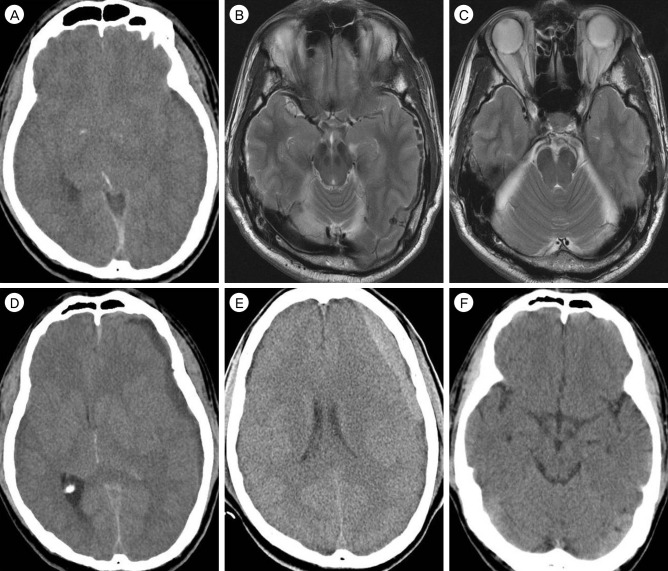1. Bansal H, Chaudhary A, Mahajan A, Paul B. Acute subdural hematoma secondary to cerebral venous sinus thrombosis: Case report and review of literature. Asian J Neurosurg. 2016; Apr-Jun. 11(2):177–180. PMID:
27057237.

2. Choi HJ, Cho CW. Anterior cranial fossa dural arteriovenous fistula presenting as subdural hematoma. J Korean Neurosurg Soc. 2010; 2. 47(2):155–157. PMID:
20224719.
3. Daniels DJ, Vellimana AK, Zipfel GJ, Lanzino G. Intracranial hemorrhage from dural arteriovenous fistulas: clinical features and outcome. Neurosurg Focus. 2013; 5. 34(5):E15. PMID:
23634919.

4. Gandhi D, Chen J, Pearl M, Huang J, Gemmete JJ, Kathuria S. Intracranial dural arteriovenous fistulas: classification, imaging findings, and treatment. AJNR Am J Neuroradiol. 2012; 6. 33(6):1007–1013. PMID:
22241393.

5. Halbach VV, Higashida RT, Hieshima GB, Rosenblum M, Cahan L. Treatment of dural arteriovenous malformations involving the superior sagittal sinus. AJNR Am J Neuroradiol. 1988; Mar-Apr. 9(2):337–343. PMID:
3128082.
6. Ito J, Imamura H, Kobayashi K, Tsuchida T, Sato S. Dural arteriovenous malformations of the base of the anterior cranial fossa. Neuroradiology. 1983; 3. 24(3):149–154. PMID:
6338411.

7. Kohyama S, Ishihara S, Yamane F, Kanazawa R, Ishihara H. Dural arteriovenous fistula presenting as an acute subdural hemorrhage that subsequently progressed to a chronic subdural hemorrhage: case report. Minim Invasive Neurosurg. 2009; 2. 52(1):36–38. PMID:
19247903.

8. Kominato Y, Matsui K, Hata Y, Matsui K, Kuwayama N, Ishizawa S, et al. Acute subdural hematoma due to arteriovenous malformation primarily in dura mater: a case report. Leg Med (Tokyo). 2004; 10. 6(4):256–260. PMID:
15363452.

9. Krishnaney AA, Rasmussen PA, Masaryk T. Bilateral tentorial subdural hematoma without subarachnoid hemorrhage secondary to anterior communicating artery aneurysm rupture: a case report and review of the literature. AJNR Am J Neuroradiol. 2004; Jun-Jul. 25(6):1006–1007. PMID:
15205138.
10. Marquardt G, Weidauer S, Lanfermann H, Seifert V. Cerebral venous sinus thrombosis manifesting as bilateral subdural effusion: case report. Acta Neurol Scand. 2004; 109(6):425–428. PMID:
15147467.
11. Missori P, Domenicucci M, Sassun TE, Tarantino R, Peschillo S. Alterations in the intracranial venous sinuses in spontaneous nontraumatic chronic subdural hematomas. J Clin Neurosci. 2013; 3. 20(3):389–393. PMID:
23219821.

12. Nomura S, Anegawa S, Nakagawa S, Tomokiyo M, Koga H, Hayashi T. Subarachnoid hemorrhage caused by dural arteriovenous fistula of the sphenobasal sinus: case report. Neurol Med Chir (Tokyo). 2002; 6. 42(6):255–258. PMID:
12116531.

13. Ogawa K, Oishi M, Mizutani T, Maejima S, Mori T. Dural arteriovenous fistula on the convexity presenting with pure acute subdural hematoma. Acta Neurol Belg. 2010; 6. 110(2):190–192. PMID:
20873450.
14. Oh JS, Yoon SK, Oh HJ, Shim JJ, Bae HG, Lee KS. Endovascular treatment of dural arteriovenous fistulas: single center experience. J Korean Neurosurg Soc. 2016; 1. 59(1):17–25. PMID:
26885282.

15. Pappas CTE, Zabramski JM, Sheiter AG. Iatrogenic arteriovenous fistula presenting as a recurrent subdural hematoma: case report. J Neurosurg. 1992; 1. 76(1):134–136. PMID:
1727151.
16. Peng T, Liu A, Jia J, Jiang C, Li Y, Wu Z, et al. Risk factors for dural arteriovenous fistula intracranial hemorrhage. J Clin Neurosci. 2014; 5. 21(5):769–772. PMID:
24291477.

17. Signorelli F, Della Pepa GM, Sabatino G, Marchese E, Maira G, Puca A, et al. Diagnosis and management of dural arteriovenous fistulas: a 10 years single-center experience. Clin Neurol Neurosurg. 2015; 1. 128(1):123–129. PMID:
25496935.

18. Suzuki K, Kamezaki T, Tsuboi K, Kobayashi E. Dural cavernous angioma causing acute subdural hemorrhage: case report. Neurol Med Chir (Tokyo). 1996; 8. 36(8):580–582. PMID:
8831201.

19. Takahashi S, Shinoda J, Hayashi T. Cerebral venous sinus thrombosis in an adult patient presenting as headache and acute subdural hematoma. J Stroke Cerebrovasc Dis. 2012; 5. 21(4):338–340. PMID:
21185743.

20. Van Rooij WJ, Sluzewski M, Beute GN. Dural arteriovenous fistulas with cortical venous drainage: incidence, clinical presentation, and treatment. AJNR Am J Neuroradiol. 2007; 4. 28(4):651–655. PMID:
17416815.
21. Yang WH, Lu MS, Cheng YK, Wang TC. Pial arteriovenous fistula: a review of literature. Br J Neurosurg. 2011; 10. 25(5):580–585. PMID:
21501060.







 PDF
PDF ePub
ePub Citation
Citation Print
Print



 XML Download
XML Download